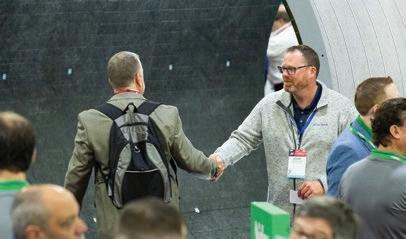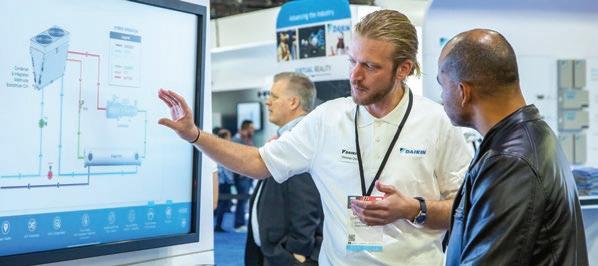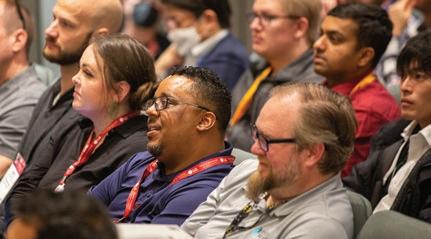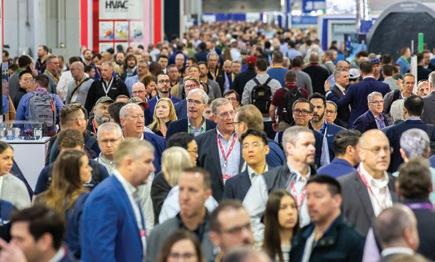August 2023
AMCA announces publication of ANSI/ AMCA Standard 540-23
Danfoss in deep decarbonisation initiative
REFCOLD India to discuss food spoilage
EBTRON named to CABA Board of Directors
‘I SEE THE

August 2023
AMCA announces publication of ANSI/ AMCA Standard 540-23
Danfoss in deep decarbonisation initiative
REFCOLD India to discuss food spoilage
EBTRON named to CABA Board of Directors
‘I SEE THE
OF
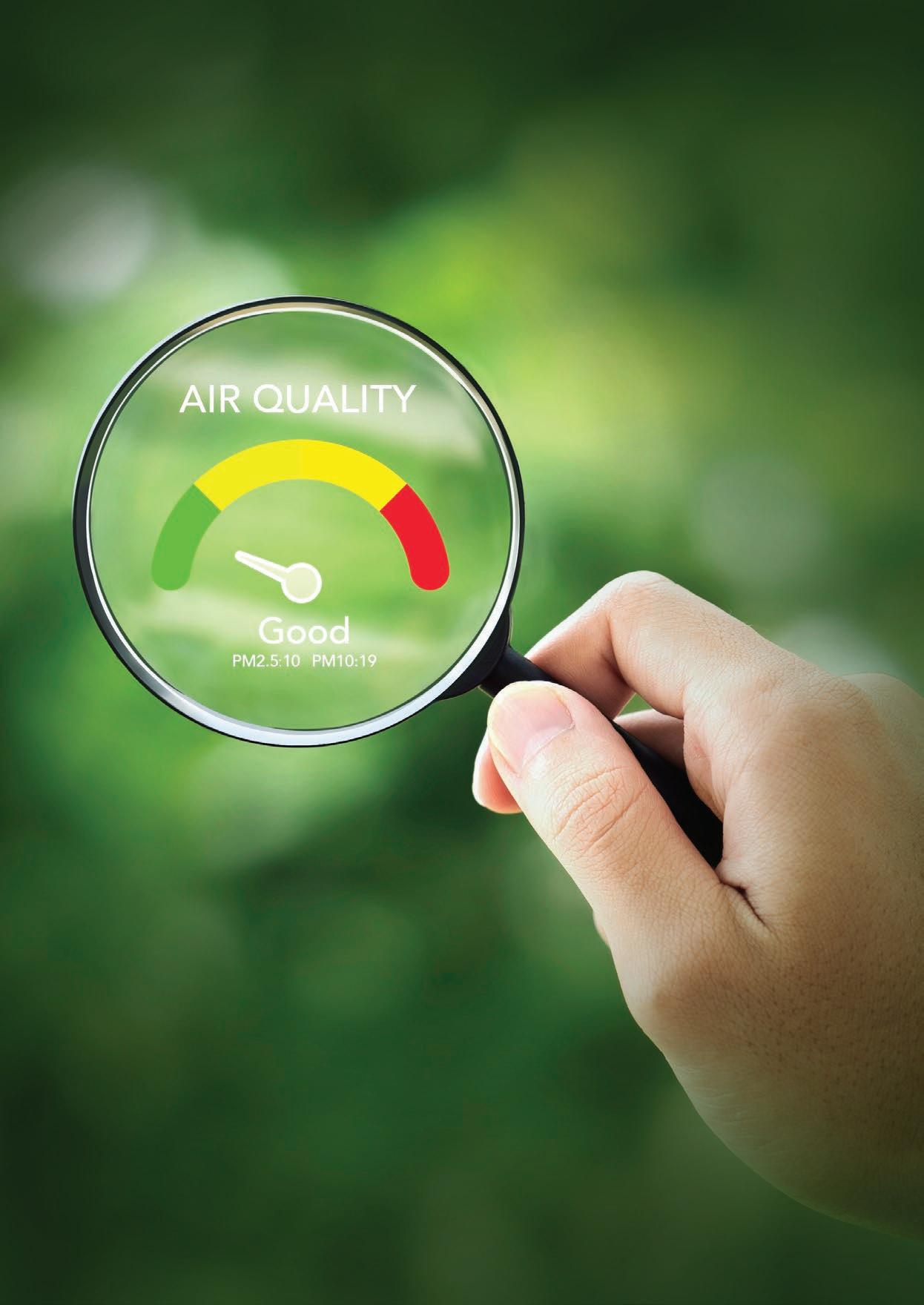
Budgetary concerns, focus on short-term solutions and lack of granular awareness of IAQ continue to plague uptake of related technologies
Elephant in the COP28 negotiating room
The ubiquitous nature of inverter ACs
MARKET FEATURE
Dr Rajendra Shende, FormerDirector,
UNEPNabil Shahin, Technical Director, AHRI MENA
Split systems: The key factors sustaining the interest in them
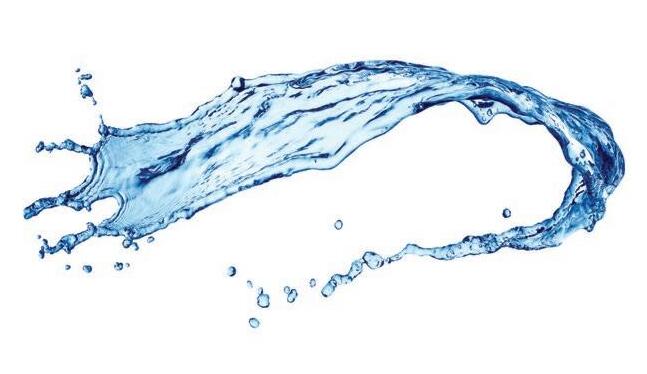
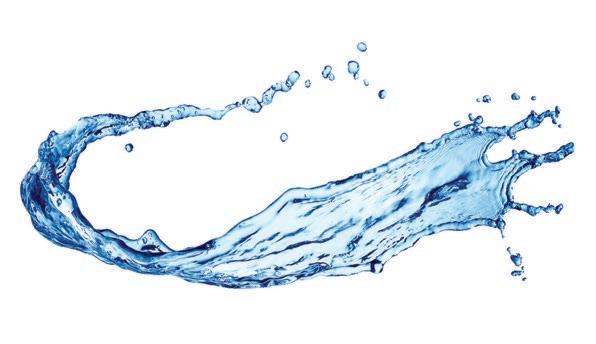
A lasting solution to the knotty issue of climate finance is one of the eagerly looked-forward-to outcomes, says Dr Rajendra Shende, Former Director, UNEP
SPLIT DECISION? HARDLY SO!

Split systems command a substantial market size, enjoy consensual support and are even attracting energy efficiency- and safety-related regulations specific to them in the GCC region
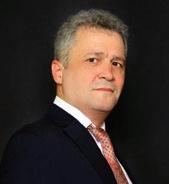
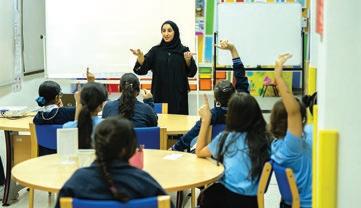

Editor
The world’s urban population is growing by approximately 200,000 people per day. Of that, a significant number is of those migrating from rural pockets. In other words, more and more are moving away from the sources of food, which means an increase in carbon emissions through moving food over long distances to our cities. Whilst this could open an argument that we need to rethink the way we live and work, the fact remains that the embedded carbon in transporting food – and I am not even speaking of transport refrigeration – is hard to ignore.
Enlightened town planners worry themselves sick over how much carbon our buildings emit but disproportionately less about food-related emissions. Transporting food is just one way of adding to the carbon load. What about the energy it takes to produce the food, in the first place? I might be somewhat off the mark, given that I am not privy to exhaustive global data, but we, as the human race, are emitting in the region of 10 billion metric tonnes of carbon dioxide to produce our food. And off that, horrendously enough, we are losing and wasting 40%. Which brings us to the next point – the vast majority of the food we waste ends up in landfills, where it degrades to emit methane, which is 25 times more potent than carbon dioxide in contributing to the climate crisis that we find ourselves in the midst of.
The problem needs to be attacked on two fronts. The first has to do with reassessing our lifestyle and our apparent lack of conscience over not only the inequitable availability and distribution of food but also over our acceptance that a certain portion of the food we produce would inevitably be wasted. The second has to do with strengthening our cold chain systems to preserve the food we grow from the post-harvest stage all the way till the time they land on our plates.
Food loss and food waste are pertinent points to discuss in the year of COP28. Conscience is the basis of good engineering.
Climate Control Middle East magazine proudly supports the UAE President’s initiative of declaring 2023 as the ‘Year of Sustainability’.
Co-Founder & Editorial Director Surendar Balakrishnan surendar@cpi-industry.com

Editor Surendar Balakrishnan surendar@cpi-industry.com
Assistant Editor (Online & Social Media)

Umika Pidaparthy umika@cpi-industry.com
Features Writer Indu Revikumar indu@cpi-industry.com
Advertising Enquiries
Frédéric Paillé +971 50 7147204 fred@cpi-industry.com
Sayf Camran Advertising Manager (Europe) sayf@cpi-industry.com


Co-Founder & Commercial Director Frédéric Paillé fred@cpi-industry.com


Judy Wang
Our representative in Asia (except India) +852 307 80 826 judywang2000@vip.126.com
Deep Karani
Our representative in North America +1 365 885-6849 deep.karani@cpimediagroup.com
Design Head Ulysses Galgo uly@cpi-industry.com
Webmaster Chris Lopez chris@cpi-industry.com
Database/Subscriptions Manager

Purwanti Srirejeki purwanti@cpi-industry.com
Founder, CPI Media Group Dominic De Sousa (1959-2015)

Dr Iyad Al-Attar Independent air filtration consultant, writes on specific science and technology issues relating to Indoor Air Quality, including airborne particles.
Kandasamy Anbalagan Managing Partner, Proleed Engineering Consultants, writes on the need for upholding time-tested engineering principles, which would only serve to complement advances in technology.
Antonios Dimitracopoulos Partner, BSA Ahmad Bin Hezeem & Associates LLP, writes on legal affairs pertaining to the construction industry.
Omnia Halawani Co-Founder & Co-CEO, GRFN, writes on MEP consultancy-related issues.

Krishnan Unni Madathil Auditor, Bin Khadim, Radha & Co. Chartered Accountants, carrying out an analysis of the market, writes on business opportunities for the HVACR industry.
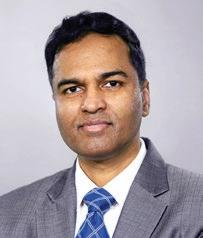
Jeremy McDonald
Principal of Guth DeConzo Consulting Engineers, in New York. He served as the technical consultant to the New York State Energy Research and Development Authority in development of an IAQ guideline for Higher Education in NY: “Covid-19 Response Guide, State University of New York”.

Dan Mizesko
Managing Partner/President, US Chiller Services International, writes on issues relating to chilled water systems, including operation & maintenance.
Nabil Shahin International Technical Director, AHRI MENA, writes on HVACR-specific regulation issues.
Published by



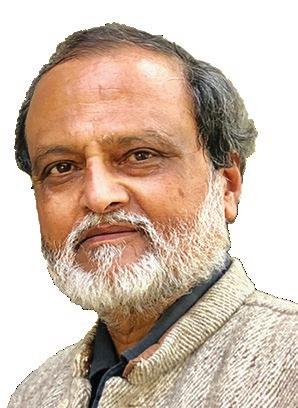
“IT IS NOT CLIMATE CHANGE, nor is it climate crisis. It is simply climate collapse.” These were the words of one of my former colleagues from the Intergovernmental Panel on Climate Change (IPCC).
He said this just about when he was getting ready to go to the 59th Session of IPCC, from July 25 to 28, in Nairobi, which would begin the process of preparing AR7, the Seventh Assessment Report. Each assessment is expected to take about 5-6 years to complete. The last report, AR6, took nine years in the making. Hence, AR7 is not expected before the year 2030, the deadline set by IPCC in AR6 to reduce greenhouse gases by at least 45% of the 2010 level.
The year 2023 will go down in history as the ‘Year of breaking records’, heat waves across Europe, a month of record-high temperature since recordcollection started, the highest marine temperature, the lowest ice cover in the Arctic and the greatest number of highlevel meetings on climate change with little impact or output.
The year 2023 started with a heated debate on climate change at a cool place – Davos, in Switzerland, in February. Interestingly, the issues in nearly 12 sessions at the World Economic Forum (WEF) were about economic instruments at the disposal of governments to tackle the climate crisis. “Tax the wealthy companies that make windfall profits and use it to finance the reduction in emission, mitigation,” was the key message in Davos from the friends of The Club of Rome, who first
brought the subject of sustainability in global discussions in the 1970s.
Indeed, nearly 3,000 years ago, when human-induced climate change was non-existent, the taxation system began for societal benefit and soon became a pan-planet framework and solution for economic injustice – that is, to take from the rich to pay the poor. Now, since human-induced climate crisis has engrossed the planet, the tax system is being pushed forward as the way out of formidable challenges, like financing the developing countries for their energy transition to clean energy, for adaptation to climate change, and for mitigating loss and damage incurred due to climate change.
Paying the poor countries for climate damages and for transitioning to a fossil-fuel-free economy, as promised by the rich countries in the last three decades, is now backlogged to more than a trillion dollars. From 2020, the backlog has been increasing at least by USD 100 billion, annually. To top it all is the funding needed for loss and damage cost to be paid by developed countries, as agreed in COP27, in Egypt. The committee constituted has yet to finalise the architecture of that fund. ‘Climate justice’, therefore, remains invisibly unaddressed.
Knowing that ‘financing the climate change’ will be the elephant in the negotiating room during COP28 in Dubai, French President Emmanuel Macron convened the bold initative, ‘Summit for a New Global Financing Pact’, in July in Paris. The initiative
of building a more responsive and inclusive global financial architecture to fight inequalities and to finance the climate transition was the goal of the Summit. Nearly 40 countries and nearly all global financial institutes, including the World Bank and the IMF, participated in the Paris Summit. There was agreement that the ‘obsolete, dysfunctional and unfair’ global financial system needs reforms. There was also consensus that the world needs a roadmap for reforms to address climate change. This, indeed, was the dire need expressed by a number of world leaders much before the Summit. While many leaders commented that one cannot start to ‘reform the system’ when faced with an urgent situation like a fast-spreading pandemic, the world now appears to have got a separate platform to address the issue of climate finance. Whether that would facilitate the negotiations in COPs in the future is something that needs to be seen.
COP28 President-Designate, H.E. Dr. Sultan Ahmed Al Jaber had also received an invitation to attend the Summit – and rightly so. While emphasising the easy availability, accessibility and even affordability of climate finance, H.E. Dr. Al Jaber said, “We need to shift the narrative that views climate finance as a burden
and recognises it as an economic opportunity.” This is a potentially inspiring and powerful statement that may set the scheduled climate negotiations in the UAE in perspective.
Firstly, it is an opportunity for developed countries to put an end to centuries-old subsidies for the production and consumption of fossil fuels like coal, oil and natural gas. As per the findings of a research undertaken by the United Nations Development Programme, the world spends an astounding USD 423 billion annually to subsidise fossil fuels for consumers –oil, electricity that is generated by the burning of other fossil fuels, gas and coal. This is four times the amount being called for to help poor countries tackle the climate crisis,
Half of these subsidies are in, and by, developed countries. When indirect costs, including costs to the environment – like the health costs due to pollution by burning fossil fuels, are factored into the subsidies, the indirect cost rises to almost USD 6 trillion, annually, according to data recently published by the International Monetary Fund (IMF). The backlog of USD 1 trillion promised by developed countries to developing countries under climate agreement looks much smaller and within the reach of developed countries
even after considering their present economic difficulties.
Worst, it is known that these subsidies, paid for by taxpayers, end up deepening inequality and impeding action on climate change, UNDP said. Continuing subsidies on fossil fuels not only makes a mockery of the global efforts to get rid of fossil fuels but also derides the fact that the world continues to spend billions of dollars on fossil fuel subsidies, while promises of finances to the developing countries for action on climate remain grossly unfulfilled.
Secondly, climate finance for investing in clean energy is an opportunity to build a sustainable world with a sustainable market mechanism. Interestingly, the price of renewable energy, like solar energy is falling rapidly. There is a need to develop the economics and social-impact case studies of places like Masdar City, in the UAE; Modhera Village, in India; and Solar Valley, in Dezhou, in the Shandong Province of China, for demonstrating them during COP28, as a source of inspiration to world leaders.
Thirdly, raising fuel prices to their fully efficient levels by reducing subsidies also reduces projected global fossil fuel-related CO2 emissions to 36%, mainly in the developed countries, below baseline levels in 2025 – or 32%
below 2018 emissions, as per UNDP. This reduction is in line with the 2550% reduction in global GHGs below 2018 levels needed by 2030 to be on track with containing global warming to the Paris Agreement goal of 1.5-2 degrees C. Globally, around 74% of the CO2 reduction comes from reduced use of coal, while 21% and three per cent, respectively are from reductions in consumption of petroleum and natural gas.

Fourthly, removal of subsidies has the power to speed up implementation of other Sustainable Development Goals (SDGs), like reducing inequality (SDG 10), Good Health and Wellbeing (SDG 3), affordable and clean energy (SDG 7) and climate action (SDG 13). H.E. Dr. Al Jabar could consider taking such a holistic and integrated approach to avail the opportunities to link climate solutions to SDGs. His technology and management background could provide proven examples to lead the COP28 negotiations.
Fifthly, phasing out subsidies and using the revenue gain for better targeted social spending, reductions in inefficient taxes, and productive investments can promote sustainable and equitable outcomes. The removal of fossil fuel subsidies would also reduce energy security concerns related to volatile fossil fuel supplies.
There is a need to show that the path to climate finance goes through bold practices rather than through Summits. H.E. Dr. Al Jaber still has a few months to show his ‘Masdar Will’ to win this impasse over finance, otherwise it could turn out to be yet another COP that would end with the usual clichéd headlines.
H.E. Dr. Al Jabar’s moment of truth has arrived. It is strengthened by the climate’s historically unmatched impacts. He is on the threshold of making UAE’s Presidency a lasting success if he gets everyone to act for integrated benefits.
CPI Industry accepts no liability for the views or opinions expressed in this column, or for the consequences of any actions taken on the basis of the information provided here.
AHRI writes a bi-monthly column on regulation-related issues in the GCC region, exclusively for Climate Control Middle East
 Shahin
Shahin
THE NEED for sustainable solutions around the globe is sparking a crucial change in the heating, ventilation and air conditioning (HVAC) industry, partly through the development and spread of HVAC inverter technology. Although this technology has been available for some time, it is steadily proving to be positive for sustainability in the HVAC sector.
Indeed, this innovation rethinks the standards of energy efficiency and operational optimisation, promising a new era for energy savings and climate control systems. This article will explore the specifics, the current scenario and the potential future impacts of HVAC inverter technology, focusing specifically on the Gulf Cooperation Council (GCC) region.
Simply put, HVAC inverter technology is an electronic component that adjusts the frequency of electricity supply to an electric motor using variable frequency drives (VFDs). The component allows the motor to operate at various speeds, rather than running constantly at full speed, resulting in a significant reduction in energy use as well as a more consistent temperature.
Harnessing the power of HVAC inverter technology, a compressor running at partial load significantly enhances the system’s energy efficiency. For instance, consider a 10 TR air conditioning system operating at 50% capacity. The compressor, utilising inverter technology, adjusts its speed to meet this reduced demand. Consequently, while the heat exchanger is engineered to handle the full 10 TR load, it now only needs to cool a 5 TR
load. This essentially means that the system is using a larger than necessary heat exchanger for a smaller load, enabling it to cool more efficiently. This adaptation to the system’s cooling demand not only optimises energy usage but also leads to substantial energy savings, epitomising the benefit of inverter technology in terms of energy efficiency.
The technology brings several other benefits, including mechanical and electrical advantages, enhanced user experiences, and increased environmental sustainability for both residential and commercial applications.
Indeed, the scope of HVAC inverter technology has dramatically expanded and is no longer limited to residential applications. It now encompasses various types of HVAC systems, making a mark across the spectrum. From split and unitary systems to variable refrigerant flow (VRF) systems and chillers, inverter technology is being used to boost energy efficiency and operational effectiveness.
Commercial refrigeration has also witnessed the integration of the technology, contributing to substantial energy savings. Water heaters employing heat pumps is another example. This widespread adoption of inverter technology signifies its growing importance across the industry, promising greater efficiency and sustainability in a diverse range of HVAC applications.
One of the most significant benefits of HVAC inverter technology is the substantial energy savings it can provide. This is primarily achieved by
adjusting the compressor’s speed in response to the cooling or heating demand. When the system operates at partial load, the inverter slows down the compressor, thus reducing energy consumption. Conversely, when a full load is required, the compressor’s speed increases to meet the demand, but even then, it does so more efficiently than a conventional HVAC system operating at full capacity. In the case of the inverter mode, the air conditioning system runs to meet partial cooling load (not full-blast cooling load) for most of the cooling season, as opposed to the less efficient on/off cycling. As a result, inverter technology can lead to energy savings of anywhere from 20% to 60%, compared to conventional, non-inverter type systems.
When paired with advanced control technology, inverter air conditioning systems offer remarkable precision in regulating indoor temperature, often to within a fluctuation of a half- to one-degree Celsius, a significant improvement compared to conventional systems, which can exhibit variations of up to five degrees Celsius. This steady temperature control helps avoid situations such as where an occupant might wake up feeling too hot or too cold. Inverter air conditioning systems can also sustain ideal relative humidity levels, typically between 40% and 60%. This capability ensures a healthier and more
comfortable indoor atmosphere, a feature especially valuable in regions with extreme climatic conditions.
These systems also operate with less noise, both for the indoor and outdoor units, contributing to a more relaxed living and working environment. Moreover, the efficient operation of inverter technology prevents system components from being overworked. By not constantly running at full load, the motors experience less wear and tear, resulting in a longer lifespan for the unit and less frequent maintenance.
Currently, HVAC systems with inverter technology comprise approximately 25% of units sold in the GCC region market, a percentage that is steadily increasing. In contrast, some regions in Europe and Japan have hit a 100% inverter share in the residential market, thanks to regulatory mandates. Other countries, such as China, are also moving in this direction, with over 70% market share for inverter equipment.
In the GCC region, plans to introduce seasonal energy efficiency methods to measure the efficiency of air conditioning units will likely encourage a shift towards inverter technology, because traditional, fixed-speed air conditioners will not be able to meet these new, higher energy efficiency standards based on the Seasonal Energy Efficiency Ratio (SEER).
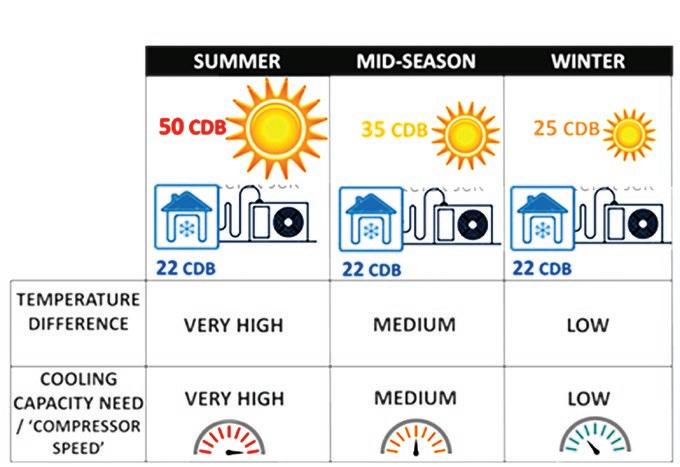
The Air-Conditioning, Heating, and Refrigeration Institute (AHRI), through its recently established MENA
standards technical committees, is making strides toward developing customised standards for this equipment. The committees –comprising international and regional manufacturers, regulatory bodies, consultants, test labs and other stakeholders – are collaboratively working on seasonal and integrated energy efficiency ratio calculations and test methods, specifically tailored for regions with high-ambient temperatures. Upon the standards’ revision, they will be submitted to the relevant regulatory bodies for adoption.
Manufacturers in the region need to be prepared for this inevitable shift towards inverter technology. To meet future higher energy efficiency standards, regional manufacturers would be advised to dedicate resources into researching and developing inverter technology.
Another key consideration for manufacturers planning to design inverter-based HVAC equipment for the high-ambient conditions of the GCC region pertains to the cooling of electronic circuit boards, specifically Variable Frequency Drives (VFDs) and processors. It is universally known that heat is a major adversary for electronic components, making it critical to ensure these circuit boards are kept cool during operation, especially for outdoor equipment. Some innovative manufacturers have employed the
practice of using refrigerant lines to cool their processors and other essential components. Other effective cooling methods exist, as well.
To maximise the benefits of HVAC inverter technology, consider these best practices:
• Prioritise Education: Engineers, installers and end-users alike need training in, and a thorough understanding of, this technology for optimal AC system sizing and proper installations to maximise the efficiency gains.
• Embrace IoT and AI: Integrating these technologies can significantly improve the performance and convenience of HVAC systems.
• Focus on preventive maintenance: Use of predictive analytics can help avoid potential system issues, reducing sudden breakdowns and extending the system’s lifespan.
• Go for Energy Efficiency: Choose HVAC systems that work with renewable energy sources to ensure cost-effectiveness and a smaller carbon footprint.
The advancement of HVAC inverter technology signals a move towards greater sustainability, efficiency and functionality within the HVAC industry. It’s crucial for consumers and industry professionals in the GCC region to stay updated with the latest developments to fully leverage its potential.
Looking forward, superior temperature control, energy efficiency and sustainability through HVAC inverter technology will become the norm. It is especially vital for manufacturers in the GCC region to prepare for a future where climate control systems better align with the ever-changing environmental and energy standards.
YOUR COOLING NEEDS VARY OVER THE YEAR! SO, YOUR AIR CONDITIONER SHOULD DO

AMIDST THE FAR-REACHING effects of the pandemic, Indoor Air Quality (IAQ) is widely recognised as a defence mechanism in mitigating viral load, which has led to heightened awareness about IAQ measures, says Samiullah Khan, CEO, Saif Air Technologies. However, despite the consensus amongst public health officials and experts on the effectiveness of ventilation, air filtration and humidity control in reducing airborne transmission of viruses, the adoption of these measures has been slow, Khan says. Further, elaborating on the sluggish response towards the adoption of IAQ measures, Khan says several reasons, including cost and budgetary concerns, lack of regulation and guidelines, focus on short-term solutions, uncertainty and complexity, and lack of granular
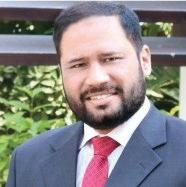
awareness hinder their widespread adoption.
Despite the challenges, Khan says, it is important to note that the awareness of good IAQ’s role in infection prevention has led to increased research and focus
on building design, ventilation standards and IAQ guidelines. Furthermore, he says, building codes and standards are likely to evolve to include specific IAQ recommendations in light of the pandemic experience. “Over time, as more evidence accumulates on the link between IAQ and infectious disease transmission, and as technology advances, the adoption of IAQ measures is likely to increase,” he says. “Organisations, businesses and building owners may increasingly prioritise IAQ improvements as part of their overall health and safety strategies, recognising the long-term benefits of creating healthier indoor environments beyond the pandemic context.”
Addressing poor IAQ in a costeffective and implementable manner, Khan says, is crucial for building

owners in the Middle East region. Some practical solutions that can effectively tackle the common causes of poor IAQ include implementing a scheduled maintenance programme for HVAC systems, improved ventilation by installing mechanical ventilation systems, and Energy Recovery Ventilation (ERV) or Heat Recovery Ventilation (HRV) systems, which aid in energy recovery from exhaust air, Khan says. Additionally, installing high-quality air filters with a high Minimum Efficiency Reporting Value (MERV) rating, using air purifiers with HEPA or activated carbon filters, maintaining indoor humidity levels between 30% and 50% with the use of dehumidifiers, and addressing air leaks and gaps in the building envelope through sealing and proper insulation help prevent the infiltration of outdoor pollutants and maintain consistent indoor temperatures. “Educating building occupants about IAQ best practices and promoting the use of low-VOC materials during construction and renovations can significantly impact IAQ,” he says. “And finally, implementing natural ventilation strategies during mild
weather conditions and installing carbon dioxide (CO2) sensors in areas with high occupancy for real-time ventilation adjustments are essential measures to ensure effective IAQ management.”

Joining the conversation, Nerissa Deoraj, Senior Public Affairs Manager, Systemair Group, says there are many ways to effectively address poor IAQ, keeping in mind the concerns of building owners. She adds that one way is by investing in regular maintenance of ventilation systems, which includes cleaning air filters, ducts and vents and checking for
mechanical issues. “By reducing the concentration of indoor air pollutants, this initial investment not only helps improve IAQ but also helps ensure the system’s longevity,” she says.
Furthermore, Deoraj says, implementing cost-effective air quality monitoring systems within buildings, which can be connected to smart building management systems, are also helpful in cultivating greater transparency and triggering behaviour change. “This allows building occupants and owners to be aware of IAQ levels and make necessary changes in
The layout and design of the building should ideally be optimised to ensure proper airflow and air changes, and minimise sources of pollutants
temperature or humidity through the controls, if needed,” she says.
Commenting on the role of building layout and design in IAQ, she says designing with IAQ in mind means the building can be optimised to ensure adequate airflow and air changes and minimise sources of pollutants. “In general,” she says, “many quality solutions in the market can help improve IAQ in new buildings and retrofit projects.” However, she says, the design phase of a project is one of the most important stages in ensuring IAQ. “The layout and design of the building should ideally be optimised to ensure proper airflow and air changes, and minimise sources of pollutants,” she says. “This may include proper placement of windows and ventilation shafts and the use of non-toxic building materials. The same would apply to renovation and retrofits.”
Additionally, Deoraj emphasises the importance of certifications in assuring building owners that the product has been independently tested and verified to meet specific industry standards. She says, third-party certified products add credibility to the manufacturer’s performance claims. Certified products can lead to energy savings, reduced utility bills and a more sustainable approach to building operations, which can positively impact IAQ, she adds.
Khan says that despite the merits of IAQ-related products, budgetary challenges deter building owners from adopting them. Many are hesitant to allocate funds for improving IAQ, as they perceive it as an additional expense with uncertain returns. To overcome these challenges, he says, it is essential to emphasise on the long-term benefits of improved IAQ, such as reduced healthrelated costs, increased productivity and energy savings. Moreover, he says, demonstrating how IAQ improvements can lead to a healthier and more comfortable environment for occupants, and highlighting potential energy savings from more efficient HVAC systems can make the investment more appealing and will help building owners see the value in investing in IAQ measures. In addition, Khan says
government incentives or rebates –including tax breaks, grants or subsidies for implementing energy-efficient and IAQ-enhancing measures – can help overcome budgetary challenges.
Additionally, Khan says, it is important to look into the aspect of ROI or payback period for implementing IAQ solutions. IAQ improvements, he says, can have varying payback periods, with some offering quick returns, while others may take longer due to the nature of the investment and the benefits they offer. To elucidate, Khan mentions the use of Aerocide, a NASA-developed technology, and HEECO2R, a process locally developed in UAE and adopted by Fakhruddin Properties, to not only improve IAQ but also reduce power consumption by about 30%. “The
payback achieved on the electricity bill is around three years,” he says. “And a one-year payback can be achieved if the health benefits and improvement in operational efficiency are considered. Apart from financial gains, ROI for IAQ improvements can extend to nonfinancial benefits, such as improved public image and corporate social responsibility.” Furthermore, to assess the expected ROI or payback period, he says, building owners can seek assistance from IAQ consultants, energy auditors or financial experts experienced in conducting such analyses to develop a comprehensive cost-benefit analysis tailored to their building and occupants.
For her part, Deoraj says, estimated costs associated with implementing effective solutions to improve IAQ can vary depending on the specific measures adopted and the size and type of the building. However, she says, in general, many IAQ improvement solutions are relatively affordable and can often yield a positive return on investment in the long run. She says:
“It is most important to note that while the initial costs of implementing IAQ improvement measures may be present, the potential benefits far outweigh these expenses. Improved IAQ leads to several advantages, which include enhanced occupant health and wellbeing, which increases productivity and reduces

To assess the expected ROI or payback period, building owners can seek assistance from IAQ consultants, energy auditors or financial experts experienced in conducting such analyses to develop a comprehensive cost-benefit analysis tailored to their building and occupantsNerissa Deoraj
absenteeism. Energy savings are improved due to optimised ventilation and HVAC system performance, and the lifespan of the building equipment and systems is extended with proper, regular maintenance.”

Retrofitting a building to improve IAQ, Deoraj says, will support the energyefficiency goals of facilities, which can translate to more significant savings for the building owner in the long term. For instance, she says, the ventilation system in a retrofitting project must be designed with great care to achieve the required thermal and atmospheric indoor environment. The fresh-airhandling unit must be equipped with the necessary functions for air handling with the required capacity, she says. And the air distribution system, she says, must be designed considering sound levels, air velocities and the air volume requirements in the respective rooms. “If a clear focus on energy efficiency is maintained for all design aspects, a balanced mechanical ventilation system with energy recovery will be the most efficient way of achieving an excellent indoor air climate,” she says.
Deoraj says it is important to remember that correct design factors vary depending on building size, category and type, occupancy, indoor
activities, contamination sources and concentrations, building location and climate. Sharing a global perspective on the rising importance of retrofitting, she says efficient and sustainable building performance is becoming an increasingly important global concern, particularly in Europe. Governments, organisations and individuals, she says, recognise the significance of retrofitting existing buildings to reduce energy consumption, lower greenhouse gas emissions and to enhance overall sustainability. “The European Union’s Energy Performance of Buildings Directive (EPBD) has set energyefficiency improvement targets, leading
to a surge in retrofitting efforts, notably with the launch of the Renovation Wave initiative in 2020,” she says.
For his part, Khan says, factors such as building size, complexity and necessary upgrades can impact the cost-effectiveness of IAQ retrofitting. Larger and more complex buildings, he says, require more extensive retrofits and, therefore, have higher upfront costs. However, he says, the potential energy savings and operational cost reductions over time can be significant, making these investments cost-effective in the long run. “The payback period for IAQ retrofitting measures can vary depending on factors like local energy costs, the extent of retrofitting and available incentives,” he says. “Building owners should conduct a thorough costbenefit analysis, taking into account factors such as energy savings, reduced maintenance costs, potential tenant retention benefits, and the health and productivity improvements associated with better IAQ.” Moreover, he says, working with IAQ experts and energy auditors can help building owners identify the most appropriate retrofitting measures for their specific building and occupancy needs. These professionals, he says, can provide valuable insights into the potential energy savings and IAQ improvements, assisting building owners in making informed decisions to optimise energy efficiency and IAQ in their properties.
If a clear focus on energy efficiency is maintained for all design aspects, a balanced mechanical ventilation system with energy recovery will be the most efficient way of achieving an excellent indoor air climate
FOR EDITORIAL-RELATED QUERIES: Surendar Balakrishnan Co-Founder & Editorial Director

M: +971 50 509 2457
E: surendar@cpi-industry.com
FOR EVENT AND MARKETING-RELATED QUERIES:

Namrata Aswani
Strategic Public Affairs Liaison and Events Manager
M: +971 50 5522461
E: namrata@cpi-industry.com
IN ASIA (EXCEPT INDIA), CONTACT: Judy Wang
Our representative in Asia
T: 00852-30780826
E: judywang2000@vip.126.com
IN KSA (RIYADH), CONTACT:

Hamad Syed
T: +96657 017 7925
E: hamadsyed@dhubs.io
(OUR REPRESENTATIVE IN NORTH AMERICA)
MEERAKI MEDIA
Deep Karani
T: +1(365)885-6849
E: deep.karani@cpimediagroup.com
Split systems command a substantial market size, enjoy consensual support and are even attracting energy efficiency- and safety-related regulations specific to them in the GCC region. Indu Revikumar, Features Writer, Climate Control Middle East, has the story…

THE GCC REGION, known for its hot, harsh and humid climate, has always had a high demand for air conditioning systems, since General’s first desert-specified air conditioner arrived here 50 years ago, says Luay Ghussein, Senior Director - Engineering, Taqeef. In recent years, Ghussein says, there has been a noticeable trend toward the adoption of smart and connected technologies, including in the air conditioning sector, driven by sustainability and the consumer appetite for integrating advanced technologies into everyday life. This, he says, has resulted in a whole new host of smart features in today’s split air conditioning systems.
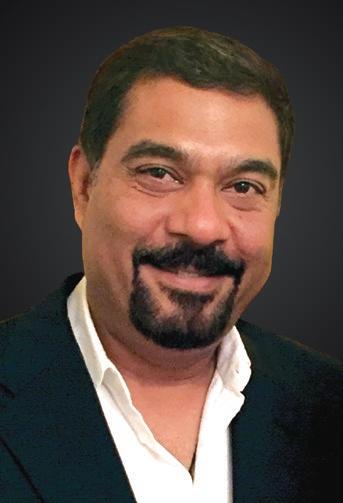
Saying that the estimated market size of split air conditioning systems in the UAE in terms of the number of units for 2023 is around 300,000 units, Ghussein adds that some of the smart features that add to their appeal include remote control and monitoring; energysaving features, such as programmable schedules and sensors that detect room occupancy; integration with smart homes; voice control options; higher-end smart systems, which utilise sensors and artificial intelligence algorithms to adapt cooling settings; maintenance alerts; connected systems, which provide data and insights of cooling patterns and energy usage; and finally the new technology, which allows the air conditioning unit to be self-cleaned with a touch of a button.
Building on Ghussein’s estimate of the market size in the UAE, Tuna Gulenc, Vice President, Daikin Middle East and Africa, says the size of the split air conditioning systems market in Saudi Arabia is approximately 800,000 units. He adds that the market size is 1.2 million units for the GCC region.
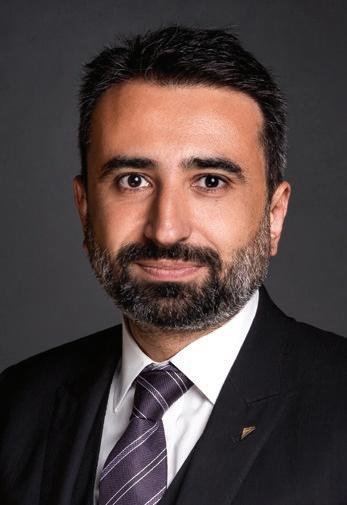
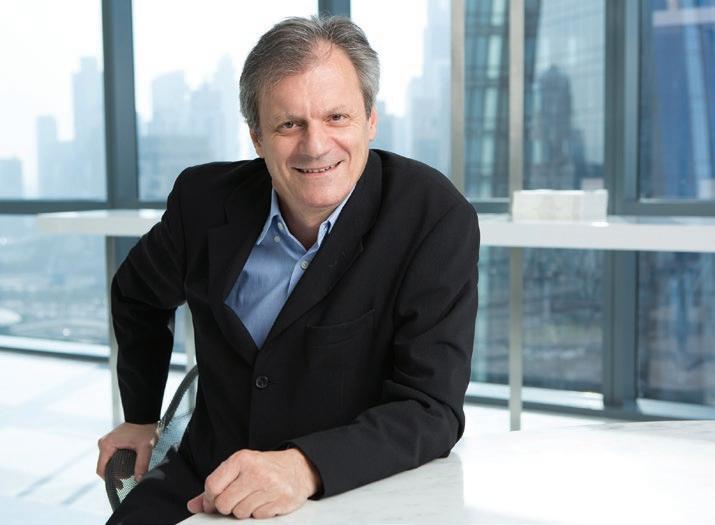
Speaking specifically on the UAE, Gulenc says the UAE HVAC market is witnessing a growing adoption of smart HVAC systems, which offer better control, building automation capabilities, and Internet of Things-enabled temperature controls through smart thermostats. He says: “Smart HVAC systems provide improved temperature variability and cleaner air compared to traditional
systems, and real-time performance monitoring results in significant energy savings. For instance, Daikin’s split unit, with a built-in occupancy sensor, allows adjusting temperature settings when it is not occupied, resulting in energy savings; and the smart thermostat introduced by Daikin in 2020 is capable of diagnosing 12 common errors in split units, thereby improving maintenance efficiency.”
Joining the conversation, Robin Kadyan, an independent consultant, says the demand for smart and
connected split air conditioning systems is on a spike with rapid technological advancements. As the adoption of smart home devices grows, he adds, consumers appreciate the ability to integrate their split air conditioning systems into their broader smart home ecosystems, and this integration will, in turn, enable automation and creates a seamless and interconnected living environment.
Shifting the discussion to the latest technological advancements in split air conditioning systems that make them
suitable for the environmental conditions in the GCC region, Gulenc says there is a general industry keenness on delivering energy-efficient and environmentally friendly solutions. For instance, Gulenc says, the use of refrigerants such as R-32 with high cooling capacity and low Global Warming Potential (GWP); the use of inverter split systems, which are a perfect fit for high-ambient conditions; and design enhancements to ensure reliable performance in harsh weather conditions are among the significant developments.
Elaborating on the impact of split units with inverters on customers, Gulenc says: “Previously, split units with a lifespan of 8-12 years consumed up to 2kW/TR, but with the introduction of inverters, this consumption has reduced significantly to almost 1.4 kW/ TR. Seasonally, these energy-efficient systems yield savings of 40-50%. Moreover, with this transition to inverter technology, customers are not only saving money but are also benefiting from increased energy efficiency, making
the switch a win-win situation for all.”

Ghussein, echoing Gulenc’s statement, says with the widespread adoption of inverter technology in the Gulf region in recent years, awareness about energy efficiency in cooling is certainly increasing. He says inverter technology can lead to substantial savings of up to 40%, if correctly selected, installed and commissioned, following the manufacturer’s recommendations. However, he says, in the Gulf region, where electricity costs are comparatively low, the return on investment may take longer, ranging from five to 10 years, depending on consumer behaviour and electricity prices. “The lifespan of these units can be five to 20 years, depending on product quality, maintenance and usage time,” he says. “Thus, the financial viability of inverter split systems, considering capital and operational expenditure, is highly contingent on various factors.”
Kadyan says manufacturers in the region have been focusing on
improving the energy-efficiency of split air conditioning systems. Higher Energy Efficient Ratings (EER), he adds, have been regulated by Emirates Authority for Standardization and Metrology (ESMA), indicating that the air conditioning unit can provide more cooling output per unit of energy consumed, making them better suited for the hot climate in the GCC region. He says, “Manufactures are also offering outdoor units to withstand the harsh coastal environment and high humidity levels by using materials and coatings that offer better corrosion resistance for the outdoor units of split AC systems.” Touching on the rising popularity of inverter technology, he says CAPEX for investing in inverter-based technology is higher as compared to non-inverter air conditioners, but considering the continuous operation of the unit for around 12 hours and more, on average, it provides end-users with an ROI of anywhere between three and five years by a reduction in OPEX.
Split air conditoning systems are not just about energy efficiency, though. Manufacturers of split air conditioning systems in the GCC region, Ghussein says, are increasingly prioritising Indoor Air Quality (IAQ), particularly given the prevalence of dust and allergens in the air. They are doing so by enhancing their filtering systems with two innovations, namely HEPA filters, which are designed to capture 99.97% of particles that are 0.3 microns or larger in size, and ionisers. These advancements, he adds, can either come as standard or optional features depending on the model, playing a pivotal role in improving IAQ and creating healthier living spaces.
Weighing in on the subject of IAQ, Gulenc says there are some premium models with advanced Apatite filter, which provides a higher level of filtration and streamer technology, which proactively releases charged particles into the room, effectively deactivating many viruses, pollens, dust particles
and odours, contributing to cleaner and healthier air. Some manufacturers, he adds, also offer air-purification products that go beyond basic filtering systems, which are designed to capture viruses, allergens, dust particles and odours with an impressive efficiency of 99.98% in just 2.5 minutes. Kadyan points to the multistage purification systems, like Nanoex, which capture and remove airborne particles. He says, “To ensure optimal air quality and allergy management, individuals in the GCC region should consider selecting an appropriate split air conditioner, maintain it regularly, and use additional air purifiers or ventilation solutions, if needed.”

With building-retrofit projects becoming increasingly popular in the region, split air conditioning systems lend themselves well to the momentum, provided they address key considerations. When retrofitting a split air conditioning system, Gulenc says, the first step is to identify the reasons and benefits of the replacement. “Once the main reasons have been defined, the next step is to schedule the mechanical, electrical and constructional works based on the customer’s desires and requirements,” he says. In some cases, he says, customers may opt to replace the HVAC components during a building renovation, while others may choose to replace only the HVAC equipment. For the latter, he says, Daikin’s dedicated installers provide quick and highquality solutions. Furthermore, he says, customers prefer to upgrade from DX split systems to more advanced and easily installable products, like VRV systems, especially for larger spaces.
Weighing in on the key considerations, Kadyan says: “There are many factors to keep in mind while retrofitting existing building’s structure and available space. If the building does not have pre-existing ductwork or refrigerant piping, retrofitting a split AC system may require additional installation work.”
Retrofitting split air conditioning systems in existing buildings in the GCC
region, Ghussein says, presents both technical and commercial challenges. For instance, he says, it’s simpler to replace a split system with another split system. However, he says, replacing window units or chillers with split systems may require more extensive modification to the building’s infrastructure, and it may create technical challenges. While discussing commercial challenges, he says, persuading clients to invest in updating a functioning unit can be difficult due to the high CAPEX required. This challenge, he adds, is further exacerbated when the client is a tenant rather than the property owner, as they may be less willing to invest in long-term infrastructure upgrades.
In the GCC region, Gulenc says regulatory bodies like ESMA and Abu Dhabi QCC (Quality and Conformity Council) are actively enforcing regulations. As splits are directly purchased by end-users, he says, many governments in the GCC region have introduced Energy Labels in the past 3-5 years. “These labels, accompanied by star ratings, aid customers in selecting the most suitable system for their needs,” he says. Given the continuous use of air conditioning throughout the year in the GCC region, it becomes crucial to assess seasonal efficiency rather than just relying on one efficiency value (EER) at specific temperatures (46 degrees C or 35 degrees C), he says. “The good news is that governments in the UAE and Saudi Arabia are now implementing CSPF (Cooling Seasonal Performance Factor) and SEER (Seasonal Energy to Efficiency Ratio) ratings,” he says. “These measures are designed to provide a more comprehensive evaluation of a system’s efficiency over the entire cooling season, promoting energy-efficient choices and environmentally friendly practices in the region.” In addition to this, Ghussein says, within the GCC region, major regulatory bodies, such as the Gulf Standardization Organization (GSO) in Saudi Arabia and the Ministry of Industry and Advanced Technology (MoIAT) in the UAE are enforcing specific regulations and standards related to the energy efficiency and safety of split air conditioning systems.

ABU DHABI DEPARTMENT OF ENERGY (DOE) announced that it has collaborated with the Family Development Foundation (FDF) to organise a series of awareness workshops as part of the Year of Sustainability. Making the announcement through a Press release, DoE said the workshops aimed to strengthen the role of government entities in promoting awareness and encouraging behavioural change, which are key aspects of Abu Dhabi Demand Side Management and Energy Rationalisation Strategy 2030.
According to the release, the workshops aimed to elevate awareness among community members and urged them to adopt a conscious and responsible lifestyle in electricity and water consumption. The release further said that the workshops also aimed to enhance the knowledge of community members about the latest modern technologies and innovative systems in this field.
The awareness workshops, DoE said, saw significant engagement from diverse sections of the community, including students, teachers, homemakers, and employees from various government and private organisations. These workshops featured educational and informative activities conducted by a team of department personnel, emphasising daily practices that actively contribute to minimising electricity and water usage, DoE further said.
According to the release, the workshops were held at the Family Development Foundation centres, namely Al Ain, Al Wathba, Zayed City, and Al Mirfa centres. Furthermore, the release said, the workshops were
implemented in schools affiliated with the FDF in Abu Dhabi and were attended by a group of female students from the foundation’s schools, as well as various segments of the community in the Al Ain and Al Dhafra regions.

Commenting on the awareness workshops, H.E. Maryam Mohammed Al Rumaithi, Director General, FDF, Abu Dhabi, said: “FDF is committed to launching workshops and awareness campaigns aimed at instilling a culture of responsible consumption in the educational sector, government and semi-governmental entities, and all
segments of society. This is in line with the framework of our integrated strategy that aims to create a mindful and sustainable society. The foundation is keen on promoting the culture of rationalisation, increasing individuals’ awareness of consumption reduction, and enriching their knowledge of energy consumption and the preservation of resources that support the journey of sustainable development.”
Aligned with the Abu Dhabi DSM Strategy 2030, which seeks to promote sustainability, H.E. Al Rumaithi said FDF embraces an approach that highlights
the importance of conscious and responsible living as a fundamental element for well-being and sustainable social progress. She added that FDF is proud to announce the successful implementation of these workshops in partnership with its strategic ally, the Abu Dhabi Department of Energy. “We are eager to deepen our collaboration and broaden its reach to create a positive impact on society, aligning with government objectives while fostering community awareness to enhance the well-being and quality of life for families,” she said.
Ahmed Juma Al Falasi, Acting Executive Director, Energy Efficiency, DoE, said, “The awareness workshops contribute to the achievement of Abu Dhabi Demand Side Management and Energy Rationalisation Strategy, which aims to reduce electricity consumption in the Emirate by 22% and water consumption by 32% by 2030.” He also added that the programmes have played a vital role in promoting a culture of responsible consumption, which will ultimately lead to achieving the desired positive change in
electricity and water consumption patterns and enhance environmentally friendly practices.
The notable accomplishment, Al Falasi said, is a direct result of the fruitful collaboration between the Department of Energy and the Family Development Foundation. He added it


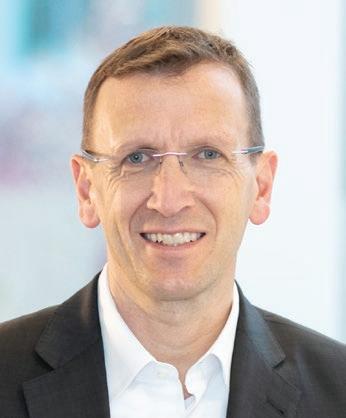 By CCME Content Team
By CCME Content Team
EMERSON has announced the appointment of Mathias Schinzel as the new president for its Middle East and Africa (MEA) region. Schinzel was with the company for 26 years, and mostly recently, he was the vice president for the DACH (Germany, Austria and Switzerland) region in Europe, Emerson said. Making the announcement through a Press release, Emerson added that Schinzel will collaborate with Emerson’s global sales leadership team to continue to grow the company’s business in the MEA region.
Roel Van Doren, Group President, Global Sales, Emerson, said: “We are pleased to have Mathias Schinzel
exemplifies the collective efforts of Abu Dhabi’s governmental organisations to provide the community with outstanding guidance on sustainability and the efficient utilisation of the Emirate’s resources. “This concerted action aims to secure a sustainable future for generations to come,” he said.
on board as our new president for the Middle East and Africa region. Moreover, we are confident that his expertise and extensive skill set will serve our customers well and help steer our business in the region to new opportunities and heights.”
According to the release, Schinzel joined Emerson in 1997 and has held key leadership positions in the United States, Asia Pacific and Europe. He also served as the Chief Financial Officer for Emerson Automation Solutions in Europe and the global isolation valves business.
Schinzel said: “I am excited to take up this new opportunity, as the Middle East and Africa is one of our fastestgrowing markets, and Emerson has a significant footprint across various industrial clusters in the region. In addition to this, we hope to leverage our automation portfolio and manufacturing and service capabilities to chart new growth opportunities across the MEA region.”

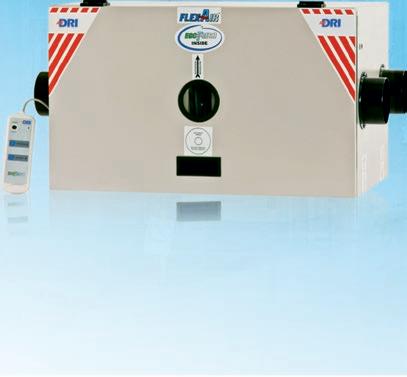
 By CCME Content Team
By CCME Content Team
THE ZA’ABEEL District Cooling Plant, owned by Emirates Central Cooling Systems Corporation PJSC (Empower), has received Gold certification from the US Green Building Council (USGBC). Making the announcement through a Press release, Empower said the recognition is a result of Za’abeel’s successful adherence to the rigorous Leadership in Energy and Environmental Design (LEED) standards, set by the USGBC. By achieving the certification, Za’abeel reaffirms its commitment to environmental protection and to reducing carbon footprint, and demonstrates its dedication to
innovation and sustainability, Empower said, adding that the accomplishment further enhances Za’abeel’s impressive portfolio of assets that have previously received similar accolades.
H.E. Ahmad Bin Shafar, CEO, Empower, said the company boasts a rich track record of accomplishments in swiftly transforming its extensive asset portfolio to align with the most stringent green building standards. “Empower has remained steadfast in establishing a sustainable model to conserve energy and preserve the environment and its resources,” Bin Shafar said. “Through close collaboration with various
government entities, the company is diligently working towards achieving the ambitious objective of carbon reduction outlined in the strategy.”
Empower said the Za’abeel District Cooling plant, part of a new generation of advanced facilities, uses state-of-theart smart and innovative technologies it has developed. The plant has garnered worldwide acclaim, particularly in the field of Thermal Energy Storage (TES), which significantly contributes to conserving a substantial amount of electrical energy, Empower said. Moreover, the plant integrates Treated Sewage Effluent (TSE) technology into its operations, making a significant contribution to reducing freshwater consumption and conserving precious natural resources, Empower further said.
In 2020, Empower initiated the construction of the Za’abeel District Cooling Plant, and the project was successfully completed in 2022, boasting a total capacity of 50,000 tons of refrigeration.












































The conference will demonstrate the special features of the Refroid Pod, the organisers say
By CCME Content TeamACONSORTIUM – comprising AG Engineering, Lexzander, Refroid, 2CRSI and Noorvia – is set to organise the REFROID Immersion Cooling Conference (https://ccme. events/refroid/registration/), on September 21 at the Habtoor Grand Resort in Dubai. Describing the event as a first-of-its-kind conference in the MEA region, the consortium said the implementation approach represents a paradigm shift in data centre cooling.
The conference will address the growing significance of immersion cooling systems, with better Power Usage Effectiveness (PUE) in the data centre landscape, to sustainably meet the escalating demand for greater storage capacity, propelled by digitalisation, AI and other related technologies, the consortium said. A key emphasis will be on how to
align with the global drive to curb and neutralise carbon emissions, the consortium added.
The conference will feature a Keynote Address by Andrew Schumer, Director of Tech & Cyber Advisory, Grant Thornton and a Plenary Address by Jacob John, CEO, AG Engineering. It will further feature presentations by Prashanth Rudrangi, Director, Refroid Technologies Private Limited; Nirmal Menon, Director, Noorvia; Vimal Kumar, Corporate Sales Manager, 2CRSI Middle East; and by S. Chandrasekar, Senior Vice President, AG Engineering.
The conference will underline the importance of embracing transformative technology to reap the benefits of unparalleled CAPEX and OPEX, ease of adoption and speed of installation, the consortium said. Commenting on the event, V Sekhar Reddy, Managing
Director, Lexzander, and Chairperson of the Conference, said: “The consortium, comprising AG Engineering, Lexzander, Refroid, 2CRSI and Noorvia, is organising the conference with the aim of making immersion cooling accessible to all. Our goal is to create sustainable, energy-efficient, future-ready IT infrastructure for our clients, aided with cost-optimised and revenuegenerating end-to-end solutions.” As the demand for computing power continues to rise, particularly with the growing utilisation of AI and similar technologies, traditional data centre designs and technologies will struggle to meet the demand for high computing and ultra-low latency, he said. The conference, which will feature a live demo of the Refroid Pod, he added, also aims to open up new possibilities to enterprises keen on addressing the increasing per-rack power consumption requirements.
According to the consortium, some of the key topics to be discussed at the event include:
• The shift from conventional aircooled systems to immersion cooling technology
• The factors that make the Refroid Pod stand out
• The nitty-gritty of installation and maintenance of the Refroid Pod
• A project management perspective: Key considerations in technical coordination, testing, commissioning and handing-over
• The ways to access the Refroid: Distribution channel
The conference will also feature a structured Q&A session, giving an opportunity to members of the audience to interact with key members of the consortium. Some of the key talking points will include downtime in retrofit projects; scope for expanding capacity and for modularisation to manage capex, considering cooling systems account for almost 80% of the total cost of a data centre; customisation and plugging all gaps: One vendor (consortium), multiple deliverables.
Those who are interested in attending may write to doveine@cpiindustry.com.

District Cooling utility provider reports a first six-month EBITDA of AED 654 million
By CCME Content Team
EMIRATES CENTRAL Cooling Systems Corporation PJSC (EMPOWER), reported consolidated financial results for the first six months of 2023. Making the announcement through a Press release, Empower said it recorded half-yearly revenue of AED 1,225 million and EBITDA of AED 654 million.
According to Empower, the consolidated revenue for the last 12 months was AED 2.86 billion (July 2022 - June 2023) compared to AED 2.63 billion (July 2021- June 2022), showing a growth of 9.1%. Further, Empower said the EBITDA for the period was AED 1.42 billion (July 2022- June 2023) compared to AED 1.28 billion (July 2021-June 2022), with a growth of 10.9%. The District
Cooling utility provider added that the first six months’ revenue and EBITDA grew by 6.1% and 7.4%, respectively, in 2023. For the same period, Empower said, its pro forma net profit grew by 7.4% to AED 464 million. This pro forma Net Profit comparison, the company added, adjusts for pre-IPO leverage to show comparable quarterly performance, and on an absolute net profit basis, it has a net profit of AED 403 million.
H.E. Ahmad Bin Shafar, CEO, Empower, said: “The results of the first half of 2023 are a realistic translation of the promises made by Empower to investors and shareholders. We aim to maintain upward, thriving and sustainable operational and financial performance to benefit
our stakeholders significantly and contribute to Dubai’s economy, its residents, and various economic sectors.” H.E. Bin Shafar added that Empower continues to take steady and consistent steps toward expanding its operations and investments in its portfolio of assets and infrastructure. Moreover, he said that this is to keep up with the growing demand in the District Cooling market in Dubai and create investment opportunities with rewarding returns for investors and shareholders.
According to Empower, the first half of 2023 witnessed significant developments in its business, including acquiring the right to operate the District Cooling systems of Dubai International Airport, with
a total capacity of 110,000 RT, valued at AED 1.1 billion. Empower said it has also entered into several exclusivity agreements, including concessions agreements with major real estate development projects, such as Dubai Maritime City (DMC), to provide its projects District

Cooling services with a capacity exceeding 63,000 RT and Sobha Real Estate to provide 17,000 RT District Cooling services for the Sobha Hartland project. During the period, Empower added, it started providing its services to DMC by connecting the Anwa residential tower in Dubai
Maritime City, with a total capacity of 1,260 RT through the company’s DMC District Cooling plant. Additionally, Empower said, it had commenced operations of its new District Cooling plant in Dubailand, with a capacity of 47,000 RT, and initiated the upgradation of its JBR District Cooling plant in Dubai with modern and innovative technologies.
During the first half of 2023, Empower said, it sponsored the International District Energy Association Conference and Exhibition, IDEA 2023, held recently in Chicago, United States, as a Diamond Sponsor. The company added that it has also won various international awards during the period, including two IDEA gold awards in the categories Total Number of Buildings Committed and Total Building Area Committed and two gold awards from the Golden Bridge Business and Innovation Awards 2022, UK.

DAIKIN Middle East and Africa, a manufacturer of air conditioning, heating, ventilation, and refrigeration solutions, announced that it has recently signed the Climate-Responsible Companies Pledge initiated by the UAE Ministry of Climate Change and Environment (MOCCAE). Making the announcement through a Press release, Daikin said it was in line with the company’s Environmental Vision 2050 and to support the UAE’s Net Zero by 2050 Strategic Initiative and Clean Energy Strategy.
The release said that Samer
Alawiah, Managing Director, Daikin UAE, represented the company at the signing ceremony and signed the pledge during the 11th instalment of the MOCCAE-hosted National Dialogue for Climate Action (NDCA). The release further said that the NDCA, a sector-specific assembly, was attended by H.E. Mariam bint Mohammed Saeed Hareb Almheiri, Minister of Climate Change and Environment.
Speaking on the occasion, Alawiah said: “We are proud and honoured to receive this opportunity by MOCCAE to sign the Climate-

Ahmed Khashan, President of Gulf Countries, Schneider Electric, says the world needs determination, pragmatism and clairvoyant leadership to get itself back on track and keep global temperatures rise to 1.5 degrees C
By CCME Content TeamSPEAKING of the upcoming COP28, in Q4 2023 in the UAE, Ahmed Khashan, President of Gulf Countries, Schneider Electric, said the world needs determination, pragmatism and clairvoyant leadership to get itself back on track and keep global temperature rise to 1.5 degrees C. Saying that it will not be easy to achieve, Khashan said Schneider Electric is committed to addressing the biggest challenges of climate change and social inequality. “That is why we signed the UAE Ministry of Climate Change and Environment’s Climate Responsible Companies Pledge, last week,” Khashan said. “This agreement binds us to implement goals to reduce carbon emissions, adopt more sustainable practices and work in the spirit of
Ahmed Khashancollaboration and cooperation to drive the Emirates towards a net-zero future.”
Khashan said the Pledge creates a foundation for collective action and shared efforts to transition to a sustainable, affordable, reliable and
Responsible Companies Pledge. This significant step formalises Daikin’s alignment with the UAE’s international climate commitments, particularly the Paris Agreement, and supports the UAE Net Zero by 2050 Strategic Initiative.” At our recent seminar, Towards a Sustainable Future, he added, we highlighted our commitment to sustainable cooling and the importance of companies and individuals collaborating and contributing equally to the government efforts of decarbonisation to build a sustainable future. He further said
modern energy landscape. To do this, Khashan said, the world urgently needs strong partnerships between the public and private sectors that combine the simplification of government regulatory policies with the adoption of innovative financing mechanism that leverage technological innovation, vocational training and capacity building. To solve the environmental challenges facing humanity, governments and businesses must collectively step up and take responsibility, Khashan said.
Signing the UAE Climate Responsible Companies Pledge shows that there is a growing, galvanised nucleus of representatives from the private sector, NGOs and government committed to sustainable transformation, Khashan said. By actively engaging in collaborative climate action, Schneider, Khashan said, hopes to inspire other organisations and stakeholders to join this collective ambition for a greener world. “It is written into our genetic DNA,” Khashan said, speaking of Schneider. “It goes into every line of code we write for the software we develop, every product we produce and every service we render across homes, buildings, data centres, infrastructure and industries.”
that signing this pledge is another move in this direction and being a responsible local citizen that is receptive to the needs of the community in which we are based.
As a signatory to the UAE Climate-Responsible Companies Pledge, Daikin said it commits


to step up its efforts to combat climate change by reducing its carbon footprint scope 1 and 2 and contributing to achieving the national net-zero target by 2050 or earlier. Daikin added that it focuses on reducing direct and indirect emissions from its products and
the high-energy efficiency systems to enhance performance and limit carbon footprints. Daikin further said it is also adopting refrigerants with a lower environmental impact to minimise greenhouse gas emissions, further contributing to a sustainable future.

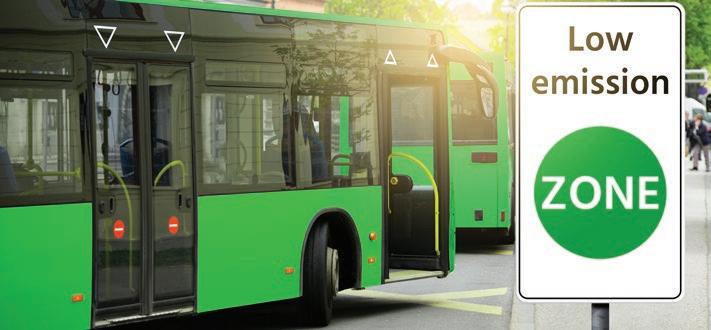 By CCME Content Team
By CCME Content Team

DANFOSS has released a whitepaper titled Roadmap for decarbonising cities. Making the announcement through a Press release, Danfoss said the whitepaper lays out a new roadmap for decarbonising cities and a pathway to enable green transition on a large scale. According to Danfoss, the whitepaper underlines how existing energy efficiency and electrification measures across sectors can immediately reduce emissions and accelerate a green transition in cities. Danfoss further said the whitepaper draws upon a diverse range of verified sources, including the latest data from the International Energy Agency (IEA), to demonstrate why action is needed and to underline how that action can be taken with solutions that are already available.
Commenting on the occasion of the release of the whitepaper, Kim Fausing, President and CEO, Danfoss, said: “We will not reach the goals of the Paris Agreement without deep decarbonisation of cities. The good news is that cities offer some of the
best possibilities to optimise urban planning and accelerate a green transition. Moreover, there are already accessible, cost-efficient technologies capable of cutting emissions sufficiently to meet global climate goals. These technologies are already in use daily, for instance, in the city of Sønderborg in southern Denmark (Project Zero), but they must be adopted more widely globally now.”
According to the latest data, Danfoss said, cities account for 70% of global carbon emissions, and ultimately, the battle against climate change will be won or lost in the cities. The company further said urgent action is needed to make changes to enable large-scale decarbonisation. According to Danfoss, as the world’s population continues its surge towards 10 billion people by 2050, it is now expected that almost 70% of the world’s inhabitants will be city dwellers by this date. In their current form, Danfoss said, with energy demand continuing to grow, cities would produce a wholly unsustainable level of emissions completely
incompatible with key climate targets, such as the 1.5 degrees C target set out by the 2015 Paris Agreement.
Ziad Al-Bawaliz, Regional President, Danfoss Turkey, Middle East and Africa, said: “Danfoss’ most recent whitepaper serves as a comprehensive guide for decarbonising cities, emphasising the pivotal role existing technologies can play in bridging a significant portion of the gap in urban greenhouse gas emissions, aligning with a 1.5 degrees C trajectory. Through practical insights and solutions, this whitepaper also paves the way for cities across our region to spearhead the transition towards a sustainable and environmentally friendly future, aligned with their ambitious decarbonisation goals.”
According to Danfoss, some of the key takeaways of whitepaper are:
• Energy-efficiency in cities is essential for global decarbonisation. If all urban areas and cities in Europe, the United States and China invested in energy-efficient heating and cooling of buildings, this would contribute 20% to the 1.5 degrees C target of the Paris Agreement.
• Electrification of vehicles will play a large role. Electrification of urban transport, both private (light) and public (heavy), is crucial for successful climate targets. Moreover, 28% of the decarbonisation necessary to stay within the 1.5 degrees C target of the Paris Agreement would be achieved if all urban areas in Europe, the US, and China electrified private and public transport.
• Improved efficiency can accelerate the electrification of transport. In passenger cars, heavy-duty vehicles, and marine transportation, efficiency measures can reduce the size of the batteries needed, thus limiting the raw material requirements. Increasing efficiency can also bring down the demand for charging infrastructure and increase the productivity and range of the vehicle.
• Implementation of existing technology for buildings, transport, and sector integration can bridge half the gap in the urban GHG emissions reductions needed for a 1.5 degrees C pathway.
Danfoss said the whitepaper would offer a concrete roadmap for mayors, local decision-makers and urban planners on how to eliminate all major drivers of cities’ carbon footprints. The company said that the paper also explores how available technologies
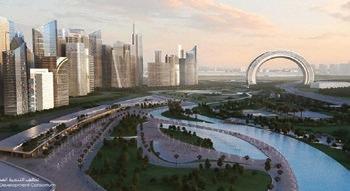
can enhance the livelihoods of citizens, create more resilient economies, and generate job opportunities simultaneously. The company further said that it provides a holistic and concrete perspective on the significant opportunities for decarbonising cities.
Allied has grown into one of the leading Engineering and Project Management firms in the Middle East, boasting offices in 3 major Countries in the Middle East (Egypt, United Arab Emirates, Kingdom of Saudi Arabia).
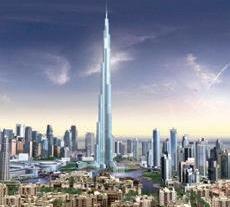
Allied offers full range of Engineering and Project Management services provided by nearly 140 dedicated professionals distributed among Egypt, UAE and KSA.
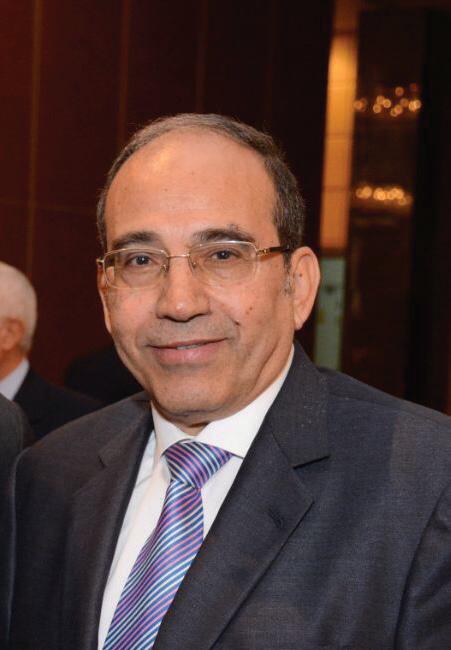
The company is a multidisciplinary consulting firm and has a track record and specialization in Buildings, Industrial Works and District Cooling and Power Generation Plants.
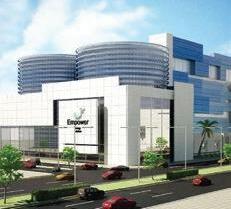
EBTRON, a thermal dispersion airflow measurement and control technology provider, announced it was named to the Continental Building Automation Association (CABA) Board of Directors. Making the announcement through a Press release, EBTRON said the company will be represented on the CABA board by Darryl DeAngelis, Director, Business Development. DeAngelis, the release said, has over 35 years of experience in HVAC and is one of EBTRON’s technology leaders responsible for spearheading the company’s business development and execution strategy.
DeAngelis said: “EBTRON is honoured to be associated with CABA, and we look forward to working with fellow board members to realize their shared vision of using advanced
technologies to accelerate the development of intelligent buildings. The members of CABA are committed to leading the way in energy reduction and promoting healthier building practices, with a strong focus on achieving netzero energy consumption.”
AIR MOVEMENT and Control Association (AMCA) International announced the publication of ANSI/AMCA Standard 540-23, a test method for louvre impacted by windborne debris. Making the announcement through a Press release, AMCA said ANSI/AMCA Standard 540-23 would supersede ANSI/AMCA Standard 54013 and establish uniform methods of laboratory testing the ability of a louvre to remain unbreached by flying debris during a windstorm.
One of the most significant changes to the standard, AMCA said, is the addition of instructions for mounting a louvre test specimen to a test frame using angle iron. While the mounting angle now
required would comply with the previous version of the standard, AMCA said that a minimum thickness was established to ensure that the mounting angle provides a rigid attachment and does not absorb appreciable amounts of impact energy from deformation.
According to AMCA, the other major changes in the ANSI/AMCA Standard 540-23 are:
• The addition of a preface defining broad objectives and uses that do not fit within the purpose and scope sections.
• The establishment of minimum performance requirements for louvres undergoing testing.
EBTRON said CABA is a non-profit industry association that conducts research and provides information, education, networking, and forums to help promote advanced technologies for intelligent buildings and the home market. The release further said that EBTRON is an active member of CABA and has recently collaborated with several other CABA members on a market study of healthy buildings and Indoor Environmental Quality for release this month.
Greg Walker, CEO, CABA, said: “DeAngelis brings not only thought leadership but also extensive industry and technical experience to the CABA board. Furthermore, this collaboration will help fuel our mission to create the smart, healthy, sustainable buildings of the future through advanced technology.”

• Corrected definitions of enhanced and basic protection, and added definitions of essential facilities, mullion or section joint, blade span, unsupported blade span, frameless section joint, and dual-blade louvre.
• Definition of the sections of Testing Application Standard (TAS) 203 and criteria for testing products subject to cyclic wind pressure loading that are to be followed during post-impact cyclic pressure tests.
• The establishment of separate failedtest procedures for impact tests and cyclic pressure tests.
• The requirement that a test report must be signed and sealed by a registered professional engineer and include cyclic-pressure-test data and results.
• The updating of all figures.
The cost of ANSI/AMCA Standard 540-23, AMCA said, is USD 45 for AMCA members and USD 90 for non-members in printed or PDF format, and USD 61 for AMCA members and USD 122 for nonmembers in both printed and PDF formats.




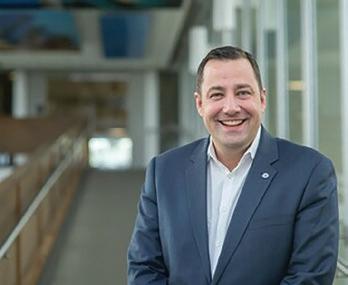 By CCME Content Team
By CCME Content Team
JOHNSON Controls announced the appointment of Marc Vandiepenbeeck as the Vice President and President of building solutions in Europe, Middle East, Africa, and Latin America (EMEALA). Making the announcement through a Press release, the company said, Vandiepenbeeck will oversee Johnson Controls’ USD 3.8 billion building solutions operations across 90 countries. The release further said that
Vandiepenbeeck would succeed Tomas Brannemo, who has led the business in the EMEALA region since 2019.
The release said Vandiepenbeeck joined Johnson Controls nearly 20 years ago, and has held roles in the company’s finance and treasury teams, and has most recently served as Vice President and Chief Financial Officer for the USD 9.3 billion building solutions business in North America.
Commenting on the new appointment, George Oliver, Chairman and CEO, Johnson Controls, said: “The business in EMEALA region is poised for a promising future, fueled by the increasing demand for our innovative solutions that make homes and buildings smarter and more sustainable. These advancements play a pivotal role in aiding our customers to achieve critical global climate targets. I am confident that Vandiepenbeeck’s leadership will further amplify the strong progress we have made in the EMEALA region while navigating global challenges, such as inflation.”
Johnson Controls said Vandiepenbeeck had been a trusted partner for Johnson Controls’ Global Services business and Global Commercial organisation, aiding the company’s digital transformation and strategic growth initiatives, including sustainability. The company also said he has held several international assignments in EMEA, the United States and Asia Pacific.

Vandiepenbeeck said: “I am honoured to join Johnson Controls in the EMEALA, especially at a time of undeniable opportunity and potential in the region. Moreover, our strategic approach and our teams’ passion for building smarter, healthier, and more sustainable tomorrows for our customers will provide us with a strong foundation for success.”





LENNOX EMEA, a division of Lennox International Incorporated, which designs and manufactures heating, air conditioning, air- handling and refrigeration equipment, announced the plan to expand and reinforce its presence in the Middle East and Africa region. Making the announcement through a Press release, the company said the strategy will include a more focused product portfolio for the region and further development of the company’s distributor network across a number of countries.
According to the release, the company is now rethinking its approach in order to take advantage of clear
growth opportunities in the MEA region market, including extremely highambient temperatures and a young population with high spending power, which elevate the potential for investing
in HVAC systems. The company added that it had introduced a larger network of local HVAC distributors in the United Arab Emirates, Saudi Arabia, Oman, Qatar, Bahrain, Kuwait, Jordan and Iraq. However, the company said it will begin offering online training to distributors and installers supported by back-office staff located in Europe.
Another major focus, LENNOX said, is to identify and develop the optimal product portfolio for the region. According to the release, the company has deployed a strategy of continuous investment in innovation and technology to keep improving the quality and performance of its products, in turn enhancing the lives of customers and responding to ever-changing expectations. The release also said that LENNOX HVAC solutions focus on attributes such as energy efficiency and reduced maintenance requirements to deliver low Total Cost of Ownership.
Cyrille Pergentini, Export Sales Manager, LENNOX EMEA, MEA region, said: “We believe our portfolio matches the strong HVAC growth in the MEA region, particularly when combined with the company’s presence through agents and local distributors in key countries.” Dubai, he added, is a hub for the entire MEA region and it’s been our historic focal point. “However, by extending our presence to countries like Saudi Arabia, we see the potential for a huge pipeline of projects. With the right approach, the right product portfolio and the right team in the region, the possibility exists to quadruple our sales in the coming years,” he said.
Among the HVAC products for the MEA market, the company said will be the full range of LENNOX split system air conditioning units, VRF solutions, and packaged units to suit home residences, offices, hotel rooms, office buildings, small retail environments, restaurants, warehouses, and shopping malls.

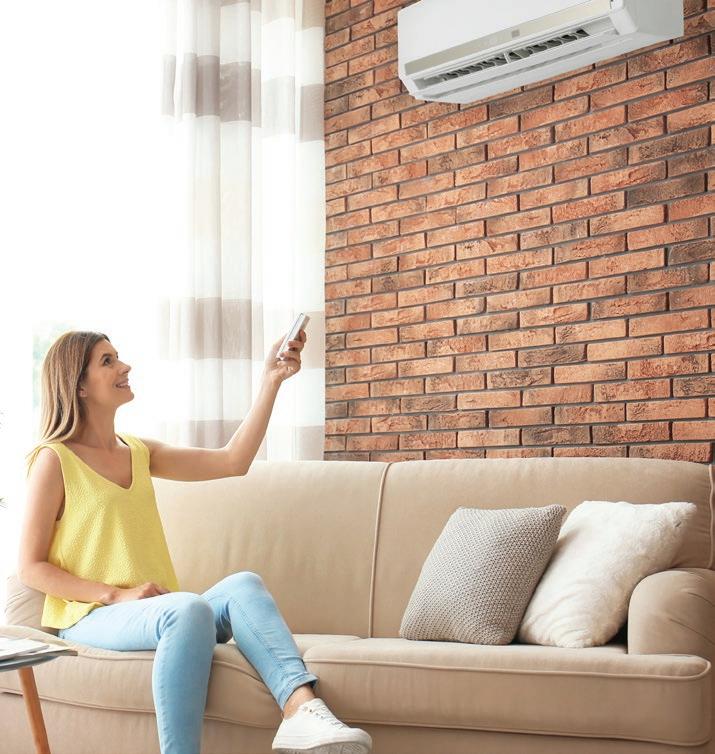

THE TWO critical factors that heavily contribute to the issue of spoilage of food produce in India are the high field heat and the challenging road conditions during transportation from the farm to the nearest cold storage facility, said Dr R Saravanan, Professor of Mechanical Engineering, R&AC Division, College of Engineering, Chennai, in India.

Dr Saravanan, who also serves as the National Secretary of the Indian Society of Heating, Refrigerating and Air Conditioning Engineers (ISHRAE), is part of the team that is in the process of producing the 6th Edition of REFCOLD India, from October 12 to 14, in Chennai. He said that REFCOLD (refrigeration and cold chain exhibition) by ISHRAE will be placing significant emphasis on addressing the urgent global challenge of food wastage. He pointed out to statistics indicating that 30-40% of vegetables and fruits are spoilt while being transported from
the farm to the nearest cold storage facility in India. This alarming reality, he said, underscores the crucial need for improved refrigeration and cold chain practices, and it will be one of the focus areas of REFCOLD.
A potential solution to mitigate the losses is to emphasise the importance of tackling field heat and improving transportation conditions, Saravanan said. To reduce the field heat, there are existing methods like evaporative cooling and conventional cooling, he said, adding that these technologies will help bring the temperature down to a range between 20 and 26 degrees C, which is ideal for the transportation of the produce in a controlled atmosphere. He further said that by implementing these pre-cooling techniques and maintaining a consistent temperature during transport, a substantial amount of produce and the quality can be preserved.
Saravanan also touched on the potential for mobile adiabatic cooling in India. This method, which involves cooling the produce directly at the site, will have a significant impact on power consumption as opposed to traditional methods of refrigeration, he said. Moreover, adiabatic cooling, he said, could also address the financial limitations faced by farmers and could help optimise the cooling processes and reduce energy costs. “The potential benefits of these strategies,” he said, “are to reduce food wastage during transportation, reduce the load on cold storage facilities and improve the quality of harvested produce in Indian conditions.”
We bring you a collection of some of the most interesting quotes, extracted from articles in this issue. In case you missed reading, we recommend you flip back to take full advantage of the insights and remarks, in the context in which they have been presented.
Fifthly, phasing out subsidies and using the revenue gain for better targeted social spending, reductions in inefficient taxes, and productive investments can promote sustainable and equitable outcomes. The removal of fossil fuel subsidies would also reduce energy security concerns related to volatile fossil fuel supplies.
Another key consideration for manufacturers planning to design inverter-based HVAC equipment for the high-ambient conditions of the GCC region pertains to the cooling of electronic circuit boards, specifically Variable Frequency Drives (VFDs) and processors.

The European Union’s Energy Performance of Buildings Directive (EPBD) has set energy-efficiency improvement targets, leading to a surge in retrofitting efforts, notably with the launch of the Renovation Wave initiative in 2020.
The good news is that governments in the UAE and Saudi Arabia are now implementing CSPF (Cooling Seasonal Performance Factor) and SEER (Seasonal Energy to Efficiency Ratio) ratings. These measures are designed to provide a more comprehensive evaluation of a system’s efficiency over the entire cooling season, promoting energy-efficient choices and environmentally friendly practices in the region.


